Table of Contents [show]
The world of gaming mice is almost as competitive as the e-sports themselves, but a small team calling themselves “Zephyr Gaming” looks to distinguish themselves by offering something fairly unique: In addition to the “standard” high-end features of OMRON switches, a 16,000 DPI sensor, and programmable RGB lighting, the Zephyr Gaming Mouse has its own internal fan to keep your hands cool and wick away sweat even during the most intense matches. The Zephyr also features patterned cut-outs to reduce weight, and the cord is lightweight paracord for added robustness.
In regards to previous competition, there was the Thermaltake Black Element Cyclone which incorporated a fan, but that was an extra attachment that plugged into the front of the mouse and only blew on your fingers. Zephyr’s design is more useful with the fan aimed at your palms.
Zephyr was kind enough to send us an engineering sample for review. They are making changes to the final product based on feedback from reviewers, and we have tried to note the changes of which we know. UltrabookReview received no payment for this review, and Zephyr wasn’t shown a copy of this article before publishing. The Zephyr Gaming Mouse can be found on Kickstarter.
APPEARANCE
The Zephyr is a neutral/non-ergonomic shape mouse, which is often popular with those who don’t like the way an ergonomically angled mouse dictates their hand angle. The body material is all matte plastic, supposedly to make the mouse easier to clean. Whether that’s true or not, the matte finish helps offset the shiny RGB. There are a series of cut-outs designed in a way that reduces the weight while still maintaining structural rigidity. I tried squeezing firmly, and there was no give under what would be considered reasonable pressure.
There is a strip of RGB lighting running around the outside of the left and right-click buttons. These LEDs also glow through the honeycomb and the transparent plastic fan blades. The scroll wheel and side sensitivity lights are a solid colour which changes to indicate what DPI sensitivity is selected.
The user can rotate the lighting to various combinations of pulsating, breathing, rainbow, solid, and so forth. The final product will have the ability to reduce the lighting brightness or switch it off completely, a welcome addition since our manufacturing sample is a bit distracting later at night without these features.
- Front of the Zephyr Gaming Mouse box
- Zephyr Gaming Mouse box side
- The pre-release sample didn’t include the blower that will come with the final retail version
USE
The question on everyone’s tongue is whether the cooling fan serves a purpose or is just a gimmick. The fan has four speed settings (Off, 4000rpm, 7000rpm, 10000rpm) controlled by a button on the underside. Our manufacturing sample only had three speed settings (Off, 4000rpm and 7000rpm). While I found the slowest setting still gave slight air movement, it was also significantly louder due to a high-pitched electronic whine. Our contact says this is an issue they’re aware of, and the fan and motor appear to be where most of the effort is going for tweaking before the retail release.
Air movement on the highest setting — while not significant — was strong enough to be felt, and my right hand didn’t feel as warm as the left. It probably couldn’t keep very sweaty hands dry, but it is believable for mildly sweaty palms to be kept under control. My hands didn’t get sweaty enough to confirm this.
The button selection includes the essentials for a gaming mouse, but those who want to bind more than a couple of actions will feel that the layout is too spartan. The mouse wheel acts as the middle button and is joined by a single button to cycle through DPI settings.
The single DPI button means that you can’t have a low-DPI sniper mode and mid-DPI repositioning mode that can be switched between with a single click. Our contact told us there has been a lot of feedback about wanting companion software for customizing settings, so this is planned for development in the future. Although if you are happy with the default 400/800/1600/3200/6400/16000 dpi levels (upgraded to include 400dpi not present in the review samples), you can memorise the number of clicks needed to get between your most-used settings with only a slight time penalty. I found that my preferred sensitivity sat in between two of the preset levels, but it only takes a bit of time to adjust.
There are two side buttons for forward/back in a browser, and they register properly as inputs in-game settings so twitch actions — such as knife — can be bound. The side button furthest from the front of the mouse has a couple of millimetres of mushy travel before reaching the switch underneath.
The shape is best suited to those with longer fingers, or who prefer to use a palm grip. The indent on the side helps with grip, but short to medium fingers will sit around the middle of the left/right-click. The switches are nicely clicky and still register quickly enough from this further back point. However, the thumb can only easily reach the rearmost of the two side buttons. If your fingers are longer or you use a palm grip, the dimensions are appropriate.
Special mention to the paracord cable for how unobtrusive it is. It feels remarkably light, flexible, and near-unnoticeable compared to modern braided
cables on mice such as the Roccat Kone let alone the more rigid older cables like the Logitech V500. What we can’t tell yet is whether there is a durability penalty here, but it certainly feels like it might break with less effort if we were to try.
The retail version includes a squeezable blower bulb to keep the fan area clear.
MEASUREMENTS
Zephyr reports the dimensions as 121.6 x 65.2 x 40.7 mm, and our test measurements matched this within an acceptable margin of error, i.e. accounting for small mistakes in our readings. Our engineering sample has a cable length of slightly over 2 metres, although the final units will have a 1.8-metre cable. This is plenty long enough to reach across a desk and down to a computer on the floor.
Where our measurements diverge is in the weight. Zephyr claims 68 g, but while this mouse does feel light, it tipped our scales at 84 g (+24%). To verify, we chucked one of our other gaming mice with a known weight of 88 g onto the scales, and the correct weight was shown. They did both feel the same weight when compared using the ‘pretend your hands are scales’ test.
Lift-off distance is vital for minimising frustrating jittery movements when repositioning the mouse during more significant movements. This is particularly noticeable when playing a first-person shooter at a low mouse DPI. At around 1.2 – 1.5 mm we found the sensor was around the edge of its lift-off range with movements registering sporadically while the at approximately 2.5 – 3.0 mm no action registered. This is in range with many other gaming mice equipped with the Pixart 3389 sensor. Pixart allows the 3389 to be configured for a 2.0 mm or 3.0 mm liftoff distance, and this one appears to be configured at 2.0 mm.
A line drawing test showed the expected small amount of smoothing that this sensor includes. The Pixart 3389 specifications indicate that there should be two frames of smoothing on the Zephyr’s lowest three dpi settings or 32 frames on the highest three.
Another advantage of choosing a high-quality sensor like this is the absence of hardware acceleration. To take advantage of this you must make sure ‘Enhanced Pointer Precision’ is disabled in ‘Settings > Devices > Mouse > Additional mouse options > Pointer options’. With this disabled, the amount of pointer movement is directly proportionate to the mouse distance movement regardless of the movement speed.
- The scroll wheel and sensitivity LEDs stay a constant colour to represent the DPI setting
- Sensitivity indicators on both sides mean the mouse can be used left handed, but the thumb buttons become difficult to access
- The RGB lighting helps accentuate the shape, but some might not like the boxiness
CONCLUSION
The Zephyr Gaming Mouse is a well-built mouse that knows the niche it wants to target.
Their potential customers here are those who want a lightweight mouse that uses well respected Omron switches and Pixart 3389 sensor. The size is smaller than classic designs like the Razer Deathadder and the shape is different, but it has similar Omron switches and the same Pixart 3389 sensor as the Deathadder had around the mid to late 2010’s before the V2 refresh.
The Zephyr is also priced comparably with the previously mentioned Razer Deathadder, at least if you get in on the early bird pricing of US$79. Here the decision comes down to the differences between the Zephyr and competing products. If you choose the Zephyr, you’re giving up ergonomic designs, desktop software for adjusting the mouse, and an established brand. What you’re gaining is a unique product that fills a niche for those who require a lightweight mouse with satisfying hardware that cools their palm while they game. For some, those trade-offs are worthwhile.
The Zephyr Gaming Mouse can be found on Kickstarter.

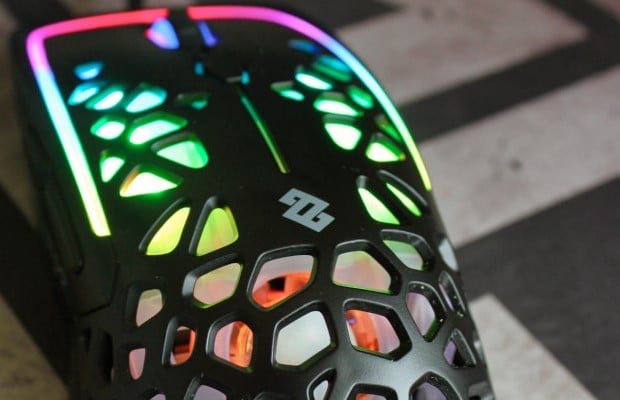
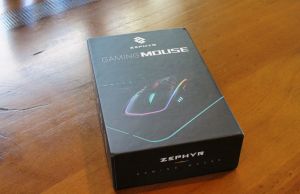
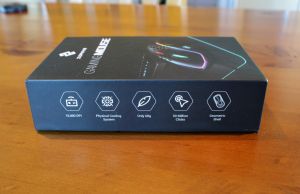
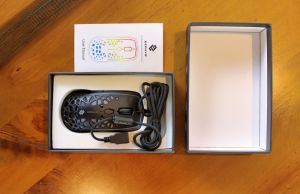
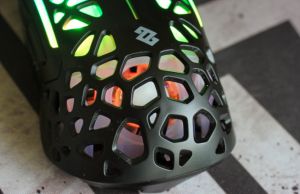
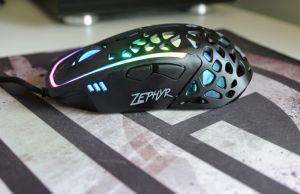
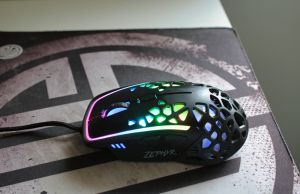
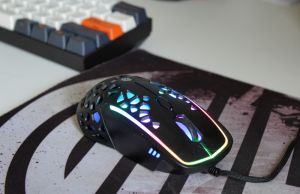
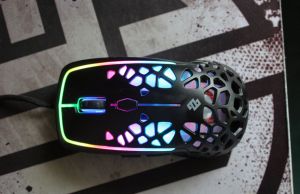


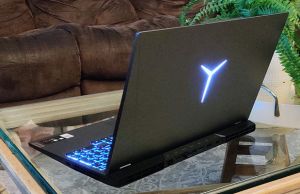
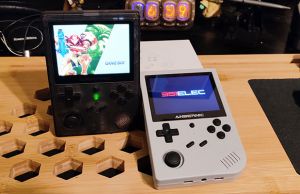
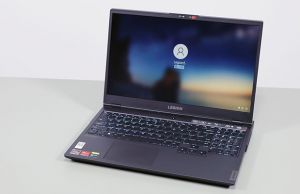
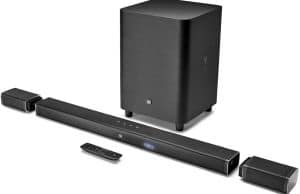
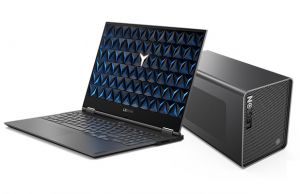




LHPSU
August 14, 2020 at 9:33 pm
How is this thing from hygiene/cleaning perspective? Seems like it's going to easily gather dust, and god forbid you ever drop something in there.
Brian O'Cralley
August 15, 2020 at 6:45 am
Good question. In terms of dust or particle ingress it doesn't seem any worse than other open-shell designs like the Finalmouse Ultralight 2. The fan is a higher risk part with moving parts and difficult access. The blower included in the retail model should help, but we weren't sent one so can't say how well it would clear the fan. It will be more difficult to keep clean than a closed-shell design.
Stacy Thompson
November 8, 2020 at 4:02 pm
I shudder to think what those mice are going to look like in a few years time, I have a Logitech G502 and dirt already gets caught in the rubber grip patterns what's it going to be like on these mice?